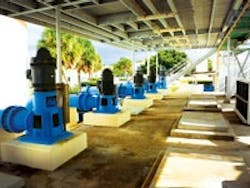About the author: John Potts is senior vice president for Kimley-Horn and Associates. Potts can be reached at [email protected] or 561.840.0847.
Water and wastewater agencies are facing a common challenge of trying to hold the line on their operating budgets. There are a number of outside influences impacting these budgets, such as rising energy prices, which show no signs of falling in the future.
Thirty years ago, energy represented a smaller part of a utility’s overall budget. Today, many new factors have emerged in the utility business, affecting a shift in energy costs and causing them to be the second highest cost, after labor. There is no doubt that regulations have required more energy-intensive treatment processes and that systems have increased in size, with more widespread systems creating longer pumping distances, increasing pumping costs. In order to minimize rate increases, many utilities can benefit in the long term by making capital investments today that will return their cost in two to seven years, followed by 10 to 50 years of reduced operating expenses.
Consumption Reduction
Energy consumption is a prime area for this type of investment, because it pays back its cost and reduces operating overhead. Each utility system is different; therefore, the areas in which energy consumption can be reduced vary with each system. All utilities generally can benefit from a close examination of flow control valves, pipe sizes, pipe flow restrictions, pump efficiency or time-of-day water production. It is not likely that a single piece of equipment can be identified and changed to result in significant energy consumption reduction. More likely, an accumulation of individual smaller reductions will add up to a savings that can be seen in the bottom line.
To effectively reduce operating costs, the total capital expenditure associated with any modification in the system should be paid back over a period of two to seven years. This can vary depending on the life expectancy of the equipment being changed. The payback period for a section of pipeline that has a 50-year life expectancy could be longer than the payback period for a pump that has a 15-year life expectancy.
System Evaluation
A flow control valve that passes 3,000 gal per minute (gpm) and has a 5-psi head loss consumes a little more than 8 hp, which, at a power cost of $0.10 per kilowatt hour, totals $16 per day, or $5,840 per year.
The same can be said of valves not being used for flow control, which, due to their configuration or size, can create a permanent and unnecessary head loss. It is not uncommon to find pipe sizes on the small side in utilities that have been growing over time. This often occurs when what were previously thought to be the outer limits of the system become the middle of the system. It seems to have been easier to increase the flow rate through a pipe rather than replace it. Close examination of today’s energy prices may show, even at this late date, that replacing pipe will pay off in the future. Pipeline generally is good for 50 to 75 years, which makes for a long payback period.
Much pipeline includes specific locations where flow is restricted, either by a valve, an air pocket at a high point or a sand deposit at a low point. These restrictions mimic a flow control valve and create an incremental head loss. The sum of many of these restrictions in a single system could represent a measurable increase in operating cost. In larger, more complex systems, it is not uncommon to discover valves that were thought to be open are, in fact, closed. These usually are located by periodically operating a hydraulic model of the system and then field verifying that model. When pressures in the field are higher than pressures in the model, there is frequently a problem that can be resolved to recover those extra pumping costs.
Pump efficiencies are an area in which energy consumption can be reduced indefinitely. The function and size of a pump are the biggest determining factors of this. It would be difficult to realize a savings in a 10-gpm sample pump related to the overall plant energy cost, regardless of its efficiency. But it is quite clear that a high-service pump running continuously can use significantly more energy with a 3% to 4% reduction in efficiency. A 3% increase in the efficiency of a 200-hp pump is 6 hp, which has a value of $3,940 per year.
Time of Day
Most electric companies offer reduced rates during certain periods of the day. Therefore, time-of-day production of treated water can determine cost. The utility must have storage capacity allowing the amount of water required in a day to be produced and stored for use later that day. Some electric companies offer price reductions of 25% to 30%, which can be significant if a plant is using a membrane process or other relatively high-energy treatment process. The costs associated with being able to take advantage of this operating cost reduction are not realted to water treatment production capacity, but rather the much less expensive treated water storage capacity. Taking advantage of this is not always possible, especially on days of maximum customer demand, when a water treatment facility may be required to operate during periods of time when electrical costs are higher. During the majority of the year, however, utilities operate at average-day production rates, and it is during those days that a larger percentage of the daily demand can be made by operating the system at a high production rate for a shorter period of time.
If your system is like most and you want to reduce your operating costs, consider closely examining or modeling your system, replacing outdated or overused pipes and parts in an aging and growing system, and taking advantage of lower electrical costs by treating water during low-rate times of day—capital improvements that will pay back their costs in the long term.
Download: Here
